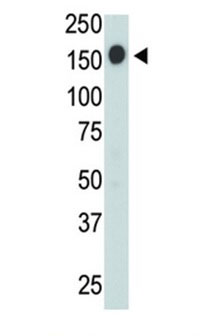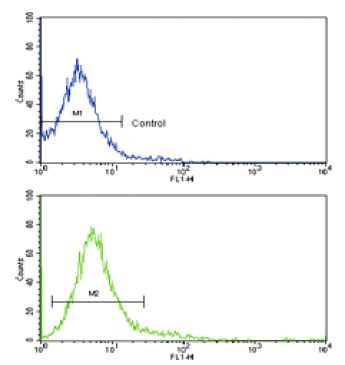CD-45 Antibody (CT)
Rabbit Polyclonal Antibody
- SPECIFICATION
- CITATIONS
- PROTOCOLS
- BACKGROUND

Application
| WB, IHC, FC |
|---|---|
| Primary Accession | P08575 |
| Reactivity | Human |
| Host | Rabbit |
| Clonality | Polyclonal |
| Isotype | Rabbit IgG |
| Calculated MW | 147486 Da |
| Gene ID | 5788 |
|---|---|
| Positive Control | Western blot: Jurkat cell lysate, IHC: human tonsil tissue, FACS: Jurkat cells |
| Application & Usage | Western blot: ~1:1000, IHC: ~1:10–1:50, FACS: ~1:10-1:50. |
| Other Names | PTPRC; CD45; Receptor-type tyrosine-protein phosphatase C; Leukocyte common antigen; T200; Flags: Precursor. |
| Target/Specificity | CD-45 |
| Antibody Form | Liquid |
| Appearance | Colorless liquid |
| Formulation | 100 µl of antibody in PBS with 0.09% (W/V) sodium azide |
| Handling | The antibody solution should be gently mixed before use. |
| Reconstitution & Storage | -20 °C |
| Background Descriptions | |
| Precautions | CD-45 Antibody (CT) is for research use only and not for use in diagnostic or therapeutic procedures. |
| Name | PTPRC (HGNC:9666) |
|---|---|
| Synonyms | CD45 |
| Function | Protein tyrosine-protein phosphatase required for T-cell activation through the antigen receptor (PubMed:35767951). Acts as a positive regulator of T-cell coactivation upon binding to DPP4. The first PTPase domain has enzymatic activity, while the second one seems to affect the substrate specificity of the first one. Upon T-cell activation, recruits and dephosphorylates SKAP1 and FYN. Dephosphorylates LYN, and thereby modulates LYN activity (By similarity). Interacts with CLEC10A at antigen presenting cell-T cell contact; CLEC10A on immature dendritic cells recognizes Tn antigen- carrying PTPRC/CD45 receptor on effector T cells and modulates T cell activation threshold to limit autoreactivity. |
| Cellular Location | Cell membrane; Single-pass type I membrane protein. Membrane raft. Synapse. Note=Colocalized with DPP4 in membrane rafts. |
| Tissue Location | Isoform 1: Detected in thymocytes. Isoform 2: Detected in thymocytes. Isoform 3: Detected in thymocytes. Isoform 4: Not detected in thymocytes. Isoform 5: Detected in thymocytes. Isoform 6: Not detected in thymocytes. Isoform 7: Detected in thymocytes Isoform 8: Not detected in thymocytes. |

Thousands of laboratories across the world have published research that depended on the performance of antibodies from Abcepta to advance their research. Check out links to articles that cite our products in major peer-reviewed journals, organized by research category.
info@abcepta.com, and receive a free "I Love Antibodies" mug.
Provided below are standard protocols that you may find useful for product applications.
Background
CD45 has been identified as a transmembrane glycoprotein, broadly expressed among hematopoietic cells. Multiple isoforms of CD45 are distributed throughout the immune system according to cell type. These isoforms arise because of alternative splicing of exons 4, 5 and 6. The corresponding protein domains are characterized by the binding of monoclonal antibodies specific for CD45RA (exon 4), CD45RB (exon 5), CD45RC (exon 6) and CD45RO (exons 4 to 6 spliced out). The variation in these isoforms is localized to the extracellular domain of CD45, while the intracellular domain is conserved. CD45 functions as a phosphotyrosine phosphatase, a vital component for efficient tyrosine phosphorylation induction by the TCR/CD3 complex. The tyrosine phosphatase activity of CD45 is contained within the conserved intracellular domain. Src and Syk family protein tyrosine kinases are utilized by the TCR/CD3 complex to initiate signaling cascades. Several members of these two families, including Lck, Fyn and ZAP-70, have been implicated as physiological substrates of CD45.
If you have used an Abcepta product and would like to share how it has performed, please click on the "Submit Review" button and provide the requested information. Our staff will examine and post your review and contact you if needed.
If you have any additional inquiries please email technical services at tech@abcepta.com.













 Foundational characteristics of cancer include proliferation, angiogenesis, migration, evasion of apoptosis, and cellular immortality. Find key markers for these cellular processes and antibodies to detect them.
Foundational characteristics of cancer include proliferation, angiogenesis, migration, evasion of apoptosis, and cellular immortality. Find key markers for these cellular processes and antibodies to detect them. The SUMOplot™ Analysis Program predicts and scores sumoylation sites in your protein. SUMOylation is a post-translational modification involved in various cellular processes, such as nuclear-cytosolic transport, transcriptional regulation, apoptosis, protein stability, response to stress, and progression through the cell cycle.
The SUMOplot™ Analysis Program predicts and scores sumoylation sites in your protein. SUMOylation is a post-translational modification involved in various cellular processes, such as nuclear-cytosolic transport, transcriptional regulation, apoptosis, protein stability, response to stress, and progression through the cell cycle. The Autophagy Receptor Motif Plotter predicts and scores autophagy receptor binding sites in your protein. Identifying proteins connected to this pathway is critical to understanding the role of autophagy in physiological as well as pathological processes such as development, differentiation, neurodegenerative diseases, stress, infection, and cancer.
The Autophagy Receptor Motif Plotter predicts and scores autophagy receptor binding sites in your protein. Identifying proteins connected to this pathway is critical to understanding the role of autophagy in physiological as well as pathological processes such as development, differentiation, neurodegenerative diseases, stress, infection, and cancer.



